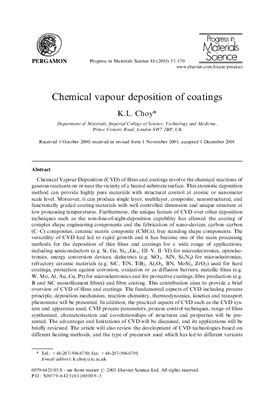Progress in Materials Science 48 (2003) 57–170
Chemical Vapour Deposition (CVD) of films and coatings involve the chemical reactions of gaseous reactants on or near the vicinity of a heated substrate surface. This atomistic deposition method can provide highly pure materials with structural control at atomic or nanometer scale level. Moreover, it can produce single layer, multilayer, composite, nanostructured, and functionally graded coating materials with well controlled dimension and unique structure at low processing temperatures. Furthermore, the unique feature of CVD over other deposition techniques such as the non-line-of-sight-deposition capability has allowed the coating of complex shape engineering components and the fabrication of nano-devices, carbon–carbon (C–C) composites, ceramic matrix composite (CMCs), free standing shape components. The versatility of CVD had led to rapid growth and it has become one of the main processing methods for the deposition of thin films and coatings for a wide range of applications, including semiconductors (e.g. Si, Ge, Si1-xGex, III–V, II–VI) for microelectronics, optoelectronics, energy conversion devices; dielectrics (e.g. SiO2, AlN, Si3N4) for microelectronics; refractory ceramic materials (e.g. SiC, TiN, TiB2, Al2O3, BN, MoSi2, ZrO2) used for hard coatings, protection against corrosion, oxidation or as diffusion barriers; metallic films (e.g. W, Mo, Al, Au, Cu, Pt) for microelectronics and for protective coatings; fibre production (e.g. B and SiC monofilament fibres) and fibre coating. This contribution aims to provide a brief overview of CVD of films and coatings. The fundamental aspects of CVD including process principle, deposition mechanism, reaction chemistry, thermodynamics, kinetics and transport
phenomena will be presented. In addition, the practical aspects of CVD such as the CVD system and apparatus used, CVD process parameters, process control techniques, range of films synthesized, characterisation and co-relationships of structures and properties will be presented.
The advantages and limitations of CVD will be discussed, and its applications will be
briefly reviewed. The article will also review the development of CVD technologies based on
different heating methods, and the type of precursor used which has led to different variants of CVD methods including thermally activated CVD, plasma enhanced CVD, photo-assisted
CVD, atomic layer epitaxy process, metalorganic assisted CVD. There are also variants such
as fluidised-bed CVD developed for coating powders; electrochemical vapour deposition for
depositing dense films onto porous substrates; chemical vapour infiltration for the fabrication
of C-C composites and CMCs through the deposition and densification of ceramic layers onto
porous fibre preforms. The emerging cost-effective CVD-based techniques such as electrostaticaerosol assisted CVD and flame assisted CVD will be highlighted. The scientific and technological significance of these different variants of CVD will be discussed and compared with other vapour processing techniques such as Physical Vapour Deposition.
Chemical Vapour Deposition (CVD) of films and coatings involve the chemical reactions of gaseous reactants on or near the vicinity of a heated substrate surface. This atomistic deposition method can provide highly pure materials with structural control at atomic or nanometer scale level. Moreover, it can produce single layer, multilayer, composite, nanostructured, and functionally graded coating materials with well controlled dimension and unique structure at low processing temperatures. Furthermore, the unique feature of CVD over other deposition techniques such as the non-line-of-sight-deposition capability has allowed the coating of complex shape engineering components and the fabrication of nano-devices, carbon–carbon (C–C) composites, ceramic matrix composite (CMCs), free standing shape components. The versatility of CVD had led to rapid growth and it has become one of the main processing methods for the deposition of thin films and coatings for a wide range of applications, including semiconductors (e.g. Si, Ge, Si1-xGex, III–V, II–VI) for microelectronics, optoelectronics, energy conversion devices; dielectrics (e.g. SiO2, AlN, Si3N4) for microelectronics; refractory ceramic materials (e.g. SiC, TiN, TiB2, Al2O3, BN, MoSi2, ZrO2) used for hard coatings, protection against corrosion, oxidation or as diffusion barriers; metallic films (e.g. W, Mo, Al, Au, Cu, Pt) for microelectronics and for protective coatings; fibre production (e.g. B and SiC monofilament fibres) and fibre coating. This contribution aims to provide a brief overview of CVD of films and coatings. The fundamental aspects of CVD including process principle, deposition mechanism, reaction chemistry, thermodynamics, kinetics and transport
phenomena will be presented. In addition, the practical aspects of CVD such as the CVD system and apparatus used, CVD process parameters, process control techniques, range of films synthesized, characterisation and co-relationships of structures and properties will be presented.
The advantages and limitations of CVD will be discussed, and its applications will be
briefly reviewed. The article will also review the development of CVD technologies based on
different heating methods, and the type of precursor used which has led to different variants of CVD methods including thermally activated CVD, plasma enhanced CVD, photo-assisted
CVD, atomic layer epitaxy process, metalorganic assisted CVD. There are also variants such
as fluidised-bed CVD developed for coating powders; electrochemical vapour deposition for
depositing dense films onto porous substrates; chemical vapour infiltration for the fabrication
of C-C composites and CMCs through the deposition and densification of ceramic layers onto
porous fibre preforms. The emerging cost-effective CVD-based techniques such as electrostaticaerosol assisted CVD and flame assisted CVD will be highlighted. The scientific and technological significance of these different variants of CVD will be discussed and compared with other vapour processing techniques such as Physical Vapour Deposition.

